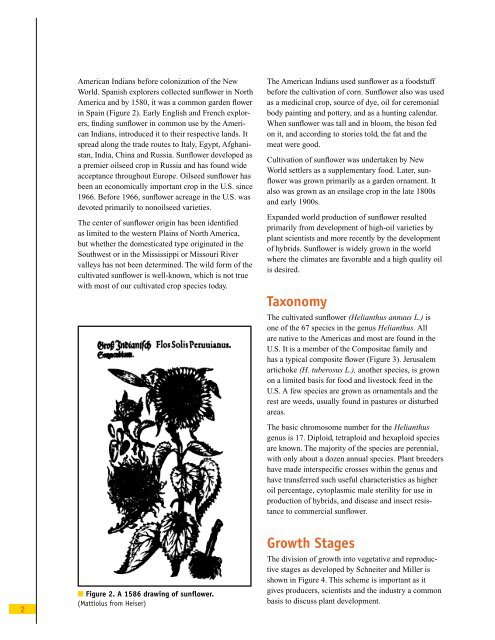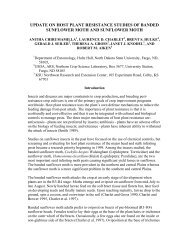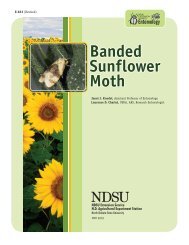Sunflower Production - NDSU Agriculture - North Dakota State ...
Sunflower Production - NDSU Agriculture - North Dakota State ...
Sunflower Production - NDSU Agriculture - North Dakota State ...
Create successful ePaper yourself
Turn your PDF publications into a flip-book with our unique Google optimized e-Paper software.
American Indians before colonization of the NewWorld. Spanish explorers collected sunflower in <strong>North</strong>America and by 1580, it was a common garden flowerin Spain (Figure 2). Early English and French explorers,finding sunflower in common use by the AmericanIndians, introduced it to their respective lands. Itspread along the trade routes to Italy, Egypt, Afghanistan,India, China and Russia. <strong>Sunflower</strong> developed asa premier oilseed crop in Russia and has found wideacceptance throughout Europe. Oilseed sunflower hasbeen an economically important crop in the U.S. since1966. Before 1966, sunflower acreage in the U.S. wasdevoted primarily to nonoilseed varieties.The center of sunflower origin has been identifiedas limited to the western Plains of <strong>North</strong> America,but whether the domesticated type originated in theSouthwest or in the Mississippi or Missouri Rivervalleys has not been determined. The wild form of thecultivated sunflower is well-known, which is not truewith most of our cultivated crop species today.The American Indians used sunflower as a foodstuffbefore the cultivation of corn. <strong>Sunflower</strong> also was usedas a medicinal crop, source of dye, oil for ceremonialbody painting and pottery, and as a hunting calendar.When sunflower was tall and in bloom, the bison fedon it, and according to stories told, the fat and themeat were good.Cultivation of sunflower was undertaken by NewWorld settlers as a supplementary food. Later, sunflowerwas grown primarily as a garden ornament. Italso was grown as an ensilage crop in the late 1800sand early 1900s.Expanded world production of sunflower resultedprimarily from development of high-oil varieties byplant scientists and more recently by the developmentof hybrids. <strong>Sunflower</strong> is widely grown in the worldwhere the climates are favorable and a high quality oilis desired.TaxonomyThe cultivated sunflower (Helianthus annuus L.) isone of the 67 species in the genus Helianthus. Allare native to the Americas and most are found in theU.S. It is a member of the Compositae family andhas a typical composite flower (Figure 3). Jerusalemartichoke (H. tuberosus L.), another species, is grownon a limited basis for food and livestock feed in theU.S. A few species are grown as ornamentals and therest are weeds, usually found in pastures or disturbedareas.The basic chromosome number for the Helianthusgenus is 17. Diploid, tetraploid and hexaploid speciesare known. The majority of the species are perennial,with only about a dozen annual species. Plant breedershave made interspecific crosses within the genus andhave transferred such useful characteristics as higheroil percentage, cytoplasmic male sterility for use inproduction of hybrids, and disease and insect resistanceto commercial sunflower.2■ Figure 2. A 1586 drawing of sunflower.(Mattiolus from Heiser)Growth StagesThe division of growth into vegetative and reproductivestages as developed by Schneiter and Miller isshown in Figure 4. This scheme is important as itgives producers, scientists and the industry a commonbasis to discuss plant development.










